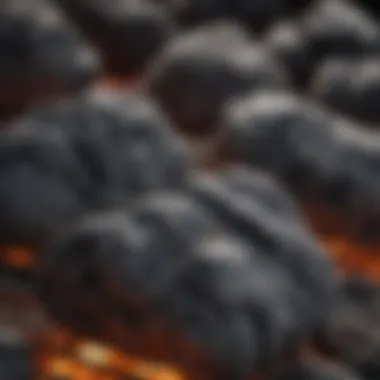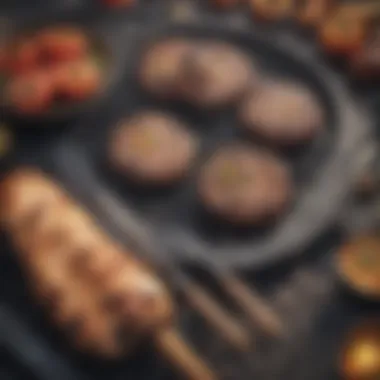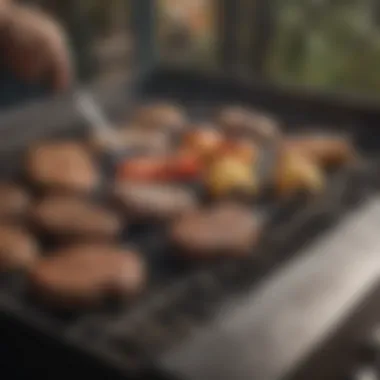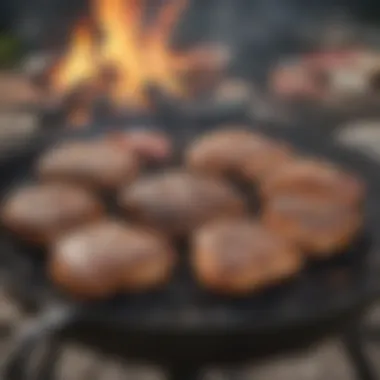Mastering the Art of Charcoal Grilling: A Complete Guide


Intro
Starting a charcoal grill might seem simple, but it requires understanding various elements that contribute to an enjoyable grilling experience. Charcoal grilling is not just about cooking food; it is about mastering a technique that enhances flavors. This guide aims to illuminate the path for both beginners and seasoned grillers alike. Knowing the right tools, types of charcoal, and steps to light a grill can significantly impact the outcome of your barbecue efforts.
Let's delve deeper into how to ignite this age-old method of cooking and make the most of it.
Recipe Overview
Charcoal grilling dates back thousands of years, originating from the desire to elevate cooking methods. The practice varies across cultures, with each region contributing unique flavors and techniques. From the rich smoky taste of Southern American barbecue to Asian-style grilled skewers, charcoal grilling offers a depth of flavor that gas grilling simply cannot replicate. This guide aspires to equip you with the knowledge to explore this grilling tradition effectively.
Ingredients List
Grilling with charcoal requires a few essential items to ensure success. Here is a comprehensive list of what you need:
- Charcoal: Choose between briquettes or lump charcoal.
- Fire starter: Options include lighter fluid or natural starters like wax cubes.
- Grilling tools: Tongs, a spatula, and a grill brush are necessary.
- Proxy elements: Optional but helpful tools like a chimney starter or heat-resistant gloves.
Special Ingredient Notes:
- If you wish to avoid chemical lighter fluids, look for natural fire starters. These are often easier on the palate, ensuring no unwanted flavors infiltrate your food.
- Briquettes give more consistent heat but can have additives that some prefer to avoid. Lump charcoal is pure wood and ignites more quickly but has a shorter burn time.
Understanding these components lays a solid foundation for starting your charcoal grill with confidence. Ease into the world of grilling by embracing the knowledge and tools that enhance the experience.
Understanding the Basics of Charcoal Grilling
Charcoal grilling is not just a cooking method; it is an experience that offers rich flavors and a unique communal atmosphere. Understanding the basics of this practice is crucial for anyone interested in mastering the craft of grilling. This foundation sets the stage for successful grilling techniques and enjoyable outcomes. Knowing how charcoal functions, its types, and the fundamental benefits of grilling helps in making informed decisions.
What is Charcoal Grilling?
Charcoal grilling refers to the process of cooking food over hot charred wood or charcoal. The heat is generated from burning charcoal, which is a material made from carbonized organic matter. This method creates high temperatures, which is perfect for searing meats, and it infuses food with distinctive aromas and flavors. The choice of what you grill, the type of charcoal used, and the handling techniques all play an essential role in achieving the desired results.
Benefits of Charcoal Grilling
The benefits of charcoal grilling go beyond mere flavor. First, the intensity of heat provided by burning charcoal is unparalleled. This high heat delivers that coveted sear, locking in juices and creating satisfying textures. Second, grilling with charcoal allows chefs to experiment with different cooking techniques, including direct and indirect grilling. This flexibility opens possibilities for diverse recipes. Additionally, the smoke from charcoal can contribute a subtle smokiness to meat, enhancing its taste.
Types of Charcoal
Cooking successfully with charcoal requires an understanding of the various types available. Here are the most common types:
Lump Charcoal
Lump charcoal is made from natural hardwood and is known for burning hotter and cleaner than other charcoal types. Its key characteristic is its ability to ignite quickly without the need for additives. This makes it a popular choice for many grillers. The unique feature is that it produces minimal ash, leading to easier cleanup. However, it can burn faster, necessitating more frequent refills.
Briquettes
Briquettes are manufactured from wood by-products combined with binders and additives that ensure even burning. One key aspect of briquettes is their consistency in burn time and heat. They tend to be more affordable and widely available, which can be appealing for beginners. However, some grillers dislike them due to the chemicals present in many brands, which can affect flavor if not managed correctly.
Natural Charcoal
Natural charcoal refers to charcoal that is free from additives and binds. This type is often produced from sustainable sources like coconut shells or hardwoods. Its primary advantage lies in its eco-friendliness and clean-burning nature. The unique feature of natural charcoal is how it delivers a pure barbecue flavor, without any interference from chemicals. The downside can be its higher price and sometimes less availability in local stores.
"Understanding different types of charcoal is essential in order to utilize them effectively for the best grilling results."
As we move through this guide, grasping these fundamentals will enhance your grilling skills, securing confidence for many grilling sessions ahead.
Essential Tools for Charcoal Grilling
In embarking on a charcoal grilling journey, having the right tools is crucial. These essential tools not only streamline the process but also enhance the quality of the grilling experience. Selecting suitable equipment can significantly affect your cooking outcome and safety, making it vital to understand each tool's purpose and functionality.


Grill Types
Open Grills
Open grills are often favored for their simple and straightforward design. The key characteristic of an open grill is its direct exposure to the elements, allowing heat to escape easily. This can be beneficial for achieving a high temperature quickly. However, the downside is that maintaining a consistent temperature can be invitingly challenging. Open grills are popular for casual gatherings, especially when catering to a crowd. Their affordability and ease of use make them a go-to option for beginners embracing the art of grilling.
Enclosed Grills
Enclosed grills feature a lid that traps heat more effectively than their open counterparts. This unique feature allows for a more controlled cooking environment, making it easier to achieve the desired doneness for meats. The ability to manage heat retention is a significant advantage, especially for slow-cooked dishes. However, they may be more expensive and require more maintenance than open grills, which can deter some new grillers.
Portable Grills
Portable grills are designed for convenience and flexibility. Their compact size allows for easy transport, making them ideal for picnics or tailgate parties. The key characteristic of portable grills is their lightweight and often foldable structure, which is very beneficial for outdoor enthusiasts. Nonetheless, they generally offer less cooking space, which can be a limitation for larger gatherings.
Lighting Tools
Charcoal Chimney
A charcoal chimney is an effective tool for igniting charcoal. Its design allows for quick and efficient lighting without the need for lighter fluid. By using a charcoal chimney, you can achieve higher temperatures faster, making it a popular choice among grillers. Its unique feature includes a top for placing paper, which ignites the charcoal from below. This method of lighting facilitates better airflow and results in less smoke. Some may find the initial investment a little high, but its longevity makes it worthwhile.
Lighter Fluid
Lighter fluid is a traditional method for igniting charcoal. It is widely available and can be stored easily. A primary advantage of lighter fluid is its convenience; only a small amount is needed to start the fire. However, the downsides include the potential for chemical flavor transfer to food if not used properly. Over-reliance on it can also lead to unsafe practices, as any spills may cause flare-ups. Therefore, proper usage and caution are necessary when opting for this method.
Electric Charcoal Starter
An electric charcoal starter has gained popularity for its ease of use. This tool eliminates the need for chemicals, relying solely on electric heat to ignite the charcoal. It generally requires less time to start a fire when compared with traditional methods. However, portable use can be limited by the need for a power source. Also, its upfront cost may be higher than more common lighting tools, which can be a deterrent for some individuals.
Safety Equipment
Heat-Resistant Gloves
Heat-resistant gloves protect your hands during grilling. Their crucial role lies in preventing burns when handling hot grills or coals. The key characteristic of these gloves is their material, which withstands high temperatures. They are a beneficial choice since they allow for more freedom of movement compared to traditional oven mitts. On the downside, high-quality gloves can be somewhat costly, but they are essential for safety.
Fire Extinguisher
Having a fire extinguisher nearby during grilling is an absolute necessity. Their primary purpose is to ensure safety by providing a quick method of extinguishing flames. The main advantage of storing a fire extinguisher is peace of mind. However, it is important to ensure it is properly maintained and within reach. Accidental fires can happen, and being prepared can make a significant difference.
Long-Handled Tools
Long-handled tools are designed to keep hands away from heat. They are essential for flipping and adjusting food without risking burns. The main benefit of using these tools lies in their ergonomic design, which often includes comfortable grips. However, they can require some getting used to, as the extended reach may feel awkward at first. Nonetheless, they significantly enhance safety and control during the grilling process.
Furthermore, incorporating these essential tools into your grilling routine enhances safety, efficiency and overall enjoyment.
Preparation Steps Before Grilling
Preparation before grilling is crucial for achieving the best results with your charcoal grill. Skipping these steps can lead to a suboptimal cooking experience, wasted resources, and potentially unsafe conditions. Careful planning can set the stage for a smooth and enjoyable grilling session, ensuring that everything goes according to plan.
Choosing the Right Location
Selecting an ideal spot for your charcoal grill is one of the most important initial steps. It influences both convenience and cook quality. Choose a flat, stable surface that is away from flammable materials including trees, fences, or buildings. A well-ventilated area will help the smoke disperse, reducing any discomfort for both the cook and the guests.
The distance from your home is another consideration. A location that is too far may require multiple trips back and forth. However, placing the grill too close to a house could create smoke issues or fire hazards. Additionally, be mindful of the wind direction. Wind can affect the temperature of the grill, making it harder to maintain the desired cooking heat.
Cleaning the Grill
A clean grill is essential for healthy and tasty grilling. Prior to lighting charcoal, inspect and clean the grill. Remove any leftover ash or old charcoal remnants from previous uses. This can prevent unwanted flavors while also reducing the risk of flare-ups.


Here’s how to clean your grill effectively:
- Use a wire brush. Scrub the grates until they are free of debris.
- Wipe down with a damp cloth to remove any remaining particles.
- Check and clean the vents to ensure proper airflow.
Taking a few moments to do this can greatly enhance flavor and cooking consistency.
Gathering Ingredients and Utensils
Preparation involves not just the grill itself, but also gathering the ingredients and tools required for your grill session. This ensures you have everything ready, reducing the chance of interruptions once you start grilling.
Start by planning your menu. Consider what proteins, vegetables, or sides you will cook. Have all meats, marinades, and rubs ready. As for utensils, ensure you have:
- Tongs and spatula for flipping and turning food.
- Basting brush to apply sauces or oils.
- Meat thermometer for checking doneness.
- Cutting board and knife for any chopping or slicing needs.
By preparing your ingredients and utensils ahead of time, you can focus on the actual grilling process, enhancing the overall experience.
How to Light a Charcoal Grill
Lighting a charcoal grill is a fundamental skill for anyone serious about grilling. The process is not just about igniting charcoal; it is about ensuring the right temperature and smoke levels for optimal cooking. If done correctly, lighting your grill can elevate the taste and texture of the food you prepare. It sets the stage for a successful grilling session.
Using a Charcoal Chimney
A charcoal chimney is an effective tool that simplifies the lighting process. It is a metal cylinder designed to hold charcoal at the top and a flammable material underneath. The design allows for efficient air circulation, leading to quicker and more even lighting.
- Load the Chimney: Fill the top section with charcoal, ensuring it's not overfilled. A loose pile of charcoal allows better airflow.
- Add Kindling: Place newspaper or a natural fire starter in the bottom chamber.
- Ignite: Light the paper through the holes to get the flames going. Within minutes, the charcoal at the top will start to glow.
- Pour Charcoal: Once the coals are covered in ash and glowing red, carefully pour them into your grill.
Using a chimney not only saves time but also minimizes the use of lighter fluid, which can affect the taste of your food.
Direct Lighting Method
The direct lighting method involves igniting charcoal directly in your grill. This method is straightforward but requires careful measures to avoid uneven lighting.
- Arrange Charcoal: Stack the charcoal in a mound in the center of the grill.
- Apply Lighter Fluid: Carefully apply lighter fluid on the coals. Be cautious not to oversaturate. A small amount goes a long way.
- Ignite: Use a long match to ignite the charcoal from the bottom. Ensure safety by standing back.
While this method can be quick, it may require some practice. Achieving the correct temperature can be tricky and smokers might not achieve the consistent flavor that a chimney can provide.
Indirect Lighting Method
The indirect lighting method is often used for larger cuts of meat and allows for slower cooking. This method takes advantage of the grill setup by arranging coals to one side.
- Charcoal Arrangement: Place lit coals on one side of the grill, leaving the other side empty for indirect cooking.
- Temperature Control: The side with coal will be hot while the other side remains cooler, providing different heat zones.
- Monitor Heat: Keep an eye on the temperature by adjusting the intake and exhaust vents accordingly.
This method allows for a more controlled cooking environment. Foods can cook evenly without the direct heat of the flames, producing better results for items that require longer cooking times.
"Using the right method for lighting a charcoal grill is essential for achieving the best flavor and texture in your grilled dishes."
Learning how to light a charcoal grill effectively not only enhances the cooking experience but also makes a notable difference in the final outcome. Each method has its own merits, and understanding when to use each one will lead to exceptional grilling results.
Adjusting Airflow for Optimal Heat Management
Adjusting the airflow in your charcoal grill is critical for effective heat management. Proper airflow controls the intensity and stability of the heat, influencing how well your food cooks. Learning to manipulate the air intake and exhaust vents can greatly enhance your grilling skills. This section explains the importance of managing airflow and how it can improve your grilling experience.
Understanding Intake and Exhaust Vents
The intake vents are located at the bottom of the grill, while the exhaust vents are positioned on the top. These vents work together to create the airflow necessary for combustion.
- Intake Vents: These allow fresh air to enter the grill. The more open the intake vent, the more oxygen gets to the charcoal. This increases the temperature, which is particularly useful for achieving high heat for searing meats.
- Exhaust Vents: These help release smoke and hot air. Adjusting the exhaust vents can often regulate the overall temperature. Keeping them slightly open will maintain a steady heat, while closing them too much can choke the fire, lowering the temperature.


It is important to note that adjustments should be gradual. Making large changes could lead to overheating or an inadequate burn, resulting in inconsistent cooking.
Controlling Temperature
Temperature control is essential for successful grilling. Different foods require different temperatures for optimal results. Understanding airflow is key to achieving and maintaining these temperatures.
- Low and Slow Cooking:
- High Heat Searing:
- Monitoring Temperature:
- When grilling larger cuts of meat like brisket, a lower and steady temperature is needed. To achieve this, keep the intake vent partially closed while opening the exhaust vent more. This allows for a slower burn and more smoke flavor without compromising heat.
- If you are cooking steaks or burgers, you want a higher temperature. In this case, open the intake vent fully and adjust the exhaust vent to maintain the heat. This helps achieve that desired sear while cooking the inside properly.
- To monitor temperature, using a grill thermometer is recommended. This can be placed in the grill vent for accurate readings. Adjust the vents while watching the thermometer for fine-tuning.
Remember: Adjustments to airflow should be more about observation and less about guesswork. Learn how your grill reacts to various adjustments to find your best approach.
Common Mistakes to Avoid
When starting a charcoal grill, there are several pitfalls that can hinder the grilling experience. Avoiding common mistakes can lead to better food, increased safety, and a more enjoyable atmosphere. Understanding these errors can not only enhance your skills but also ensure that you appreciate the process of charcoal grilling to its fullest.
Overloading with Charcoal
One of the most common mistakes is overloading the grill with charcoal. While it may seem intuitive to pile on more fuel for greater heat, it can lead to several issues. First, an excess amount of charcoal can result in uneven cooking. The middle might become excessively hot, while the edges may remain cold, leaving some food undercooked.
Moreover, overloading can produce more smoke than necessary, which can impart an unpleasant flavor to the food. This excess smoke is not only about flavor; it can also obscure visibility and create a potentially dangerous environment. To avoid this mistake, measure the appropriate amount of charcoal based on the grill size and the type of food being grilled.
Ignoring Safety Precautions
Safety is paramount when grilling, yet many people overlook essential precautions. Ignoring safety measures can lead to accidents, injuries, or even fires. Always have a fire extinguisher close to hand when grilling. Ensure that your grill is placed in a well-ventilated area, away from flammable structures such as wooden fences or trees.
Additionally, using the right tools is crucial. Employ long-handled utensils to prevent burns and maintain a safe distance from the heat. Remember, having well-fitted heat-resistant gloves is also a must when handling hot grates. Ignoring these safety tips can have serious consequences, ruining your fun and putting you at risk.
Neglecting Grill Maintenance
Maintaining your grill is integral to the grilling process. Neglecting regular maintenance can lead to malfunctions or hazardous situations. A dirty grill can affect the taste of food and, more importantly, can create flare-ups due to grease build-up. It is vital to clean the grill grates after each use.
Moreover, checking for rust or worn parts can help in identifying potential issues before they escalate. Keeping the grill covered when not in use will protect it from weather elements, ensuring its longevity. Good maintenance practices can ultimately lead to better grilling outcomes and a safer cooking environment.
Post-Grilling Care
Post-grilling care is a crucial aspect of maintaining the long-term performance of your charcoal grill. Many grillers overlook this step, yet it can significantly affect how your equipment functions in the future. Proper post-grilling care not only prolongs the life of the grill, but it also ensures that your next cooking experience is efficient and enjoyable. By adopting a routine of care, you'll keep your grill ready for many successful barbecues ahead.
Extinguishing the Charcoal
Extinguishing the charcoal properly should be your first step after you finish grilling. Allowing the charcoal to burn out on its own can be unsafe and impractical. To extinguish the coals, you can cover the grill with the lid and close the vents. This method deprives the flames of oxygen, causing the charcoal to cool down.
Another method involves using water to douse the coals. However, caution is necessary here. Pouring water directly on the charcoals can create steam and ash that might cause burns. It is also important to note that this method can create a lot of smoke. Opt for a gradual approach by sprinkling small amounts of water before fully dousing. Ensure the charcoal is completely cool before handling or discarding it.
Cleaning Your Grill
Cleaning should occur after every grilling session. It can seem tedious, but a clean grill leads to better-tasting food and improved cooking performance. Start by removing the grates. Use a grill brush to scrub away any food remnants. Make sure to pay attention to the spaces between the grates to remove stuck-on residues.
Afterward, clean the interior of the grill, including the firebox. You should also remove ash buildup, as it can obstruct airflow and affect future grilling.
For a thorough clean, consider using a mixture of warm water and mild detergent. Avoid harsh chemicals that can leave residues. Wipe down the exterior with a soft cloth to avoid scratches and maintain the appearance of your grill. Regular cleaning extends the lifespan of your grill and enhances your cooking experience.
Storing Leftover Charcoal
If you find yourself with leftover charcoal, it's essential to store it properly to maintain its effectiveness. Start by allowing the charcoal to cool completely. Once cooled, store it in a dry environment. Using a secure container that keeps moisture out is advisable, as damp charcoal will be harder to ignite the next time you grill.
For bulk charcoal, heavy-duty plastic bags or airtight containers work well. For briquettes or lump charcoal, consider using sealed buckets or bins. Label the containers with the purchase date to keep track of freshness.
Remember that poorly stored charcoal can lead to waste. Properly managing your leftover charcoal can save you money in the long run and ensure you're always ready to grill.
Proper post-grilling care ensures your grill remains in peak condition, making future grilling sessions easier and more enjoyable.



